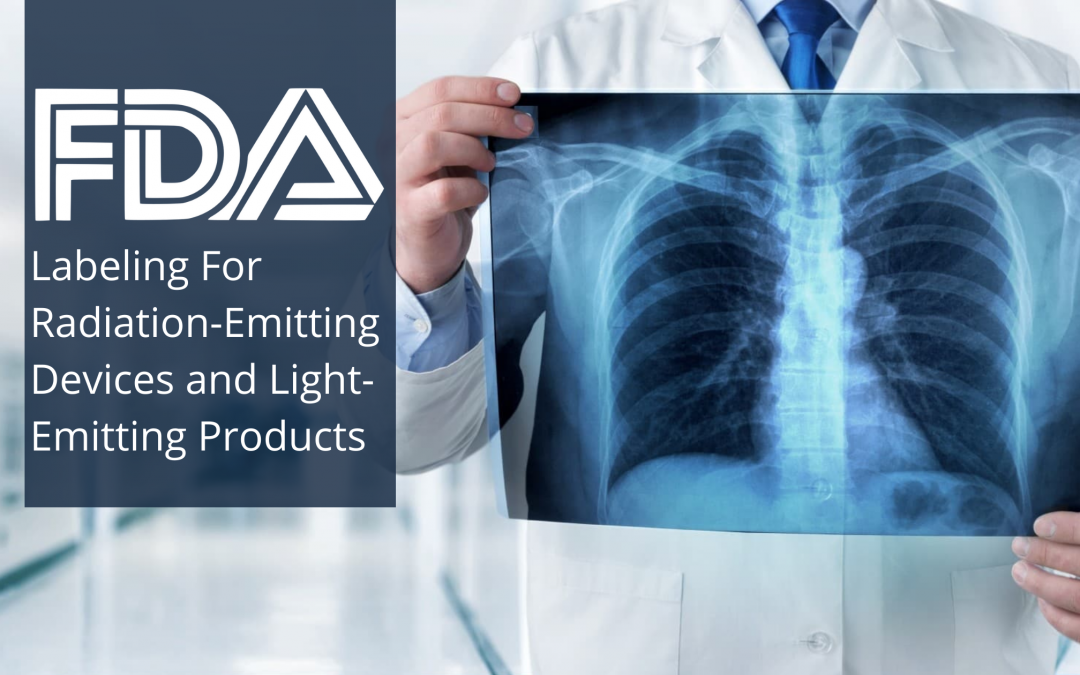
Table of Contents
As mentioned, the FDA guidance documents provide non-binding recommendations to be considered by medical device manufacturers and other parties involved in operations with medical devices. These documents clarify how the applicable requirements should be interpreted and followed in order to achieve and sustain compliance with the provisions of current legislation. The Agency additionally confirms that an alternative approach could be applied, provided such an approach complies with the applicable regulatory requirements and has been approved by the authority in advance.
Regulatory Background
According to the guidance, labeling of radiation-emitting products applies to medical devices; all products which emit ionizing, or nonionizing electromagnetic or particulate radiation; and products which emit sonic, infrasonic, or ultrasonic radiation as the result of the operation of an electronic circuit. The authority also emphasizes that the labeling requirements for radiation-emitting devices could be different from those applicable to general medical devices since radiation-emitting devices are also subject to specific requirements due to their nature and specific risks associated thereto. However, as in the case with general medical devices, labeling should contain information about the product itself and also warnings and precautions to be considered. It is also important to mention that the regulatory requirements described in the present guidance are applicable not only for radiation-emitting devices intended for medical purposes but for certain other radiation-emitting devices as they are subject to regulation by the FDA due to the hazards to public health associated thereto.
General Labeling Requirements for Electronic Products
First, the document describes the general requirements for any and all electronic products, including those intended for medical purposes and regulated as medical devices. In particular, the FDA outlines the scope of information the labeling shall contain. According to the guidance, the information shall include:
- The full name and address of the manufacturer of the product (in certain cases, it is allowed to indicate information about the distributor instead, provided that the information about the actual manufacturer(s) have been communicated to the authority in advance).
- The place and month and year of manufacture (the authority states that the information about the place of manufacture could be provided in the form of a code, provided it has been previously communicated to the authority, while the month and year of manufacture should not be coded).
Should it be impossible to use the label as described above due to the nature of the device or its design, an alternative solution should be agreed upon with the regulating authority in advance. Each manufacturer shall also provide the regulating authority with a list of all clients for which the electronic products are manufactured. If the product in question is initially intended to be exported, the appropriate label should be placed on it. If the product falls within the scope of a specific exemption, the appropriate information should also appear on the label.

Ionizing Radiation-Emitting Products
The document further describes specific requirements to be applied in the case of ionizing radiation-emitting products. In this section, the authority describes the labeling requirements for the following products:
- Cold-cathode Gas Discharge Tubes used in the production of X-rays. These products should be supplied accompanied by the instructions for use to be followed, as well as the appropriate warnings. The authority additionally emphasizes that the labels placed on such devices should remain clearly visible when it is applied in a way it should be used.
- Diagnostic X-ray Systems. With regard to such devices, the authority mentions that they could contain components that are subject to special regulatory requirements. In particular, these products should have a warning informing the user about the risks associated thereto. The Agency suggests the following wording: “WARNING: This X-ray unit may be dangerous to patient and operator unless safe exposure factors and operating instructions are observed.” If any of its components are being installed temporarily, the appropriate indication should also be provided. The same applies in the case of temporarily installed non-compatible components.
- Radiographic Equipment. According to the guidance, if the device has the capability of overriding the automatic X-ray field size adjustment in case of system failure, the override switch shall be labeled: “FOR X-RAY FIELD LIMITATION SYSTEM FAILURE”.
- Fluoroscopic Equipment is subject to the same regulatory requirements as radiographic equipment.
- Cabinet X-ray Systems should have clearly visible indications of whether the system is turned on. Additionally, special warnings addressing hazards should be provided.
Light-Emitting Products
Apart from the general radiation-emitting products, the present FDA guidance on labeling requirements also addresses certain regulatory matters associated with lasers defined for the purpose of the guidance as devices capable of producing intense radiation at a specific wavelength both for medical and industrial purposes. As in the case with any other medical devices, the labeling for such products should contain information about the manufacturer, including its name and contact details, as well as information about the device itself, the scope of which will depend on the type, class, wavelength, and power output of the particular device in question. In order to assist manufacturers in complying with the regulatory requirements described herein, the FDA also provides samples of the labels to be used.
According to the document, Class II and IIa devices should also have labeling containing special warnings, such as: “Class IIa Laser Product – Avoid Long-Term Viewing of Direct Laser Radiation.” The document further describes additional requirements to be considered in the case of Class III and IIIa products, which should also have labels informing users about potential risks associated thereto. It is stated that it is important to notify users about the risks associated with the exposure to electromagnetic radiation emitted by such products. The particular warnings to be provided would depend on the design features of these devices.
In summary, the present FDA guidance provides additional clarifications regarding the current regulatory requirements the labeling for radiation-emitting products should meet, including those applying to any radiation-emitting products and not only medical devices. The document describes how safety warnings should be provided in order to ensure those using such products are fully aware of the risks associated thereto; and also outlines the scope of the content of such warnings.
Sources:
How Can RegDesk Help?
RegDesk is a next-generation web-based software for medical device and IVD companies. Our cutting-edge platform uses machine learning to provide regulatory intelligence, application preparation, submission, and approvals management globally. Our clients also have access to our network of over 4000 compliance experts worldwide to obtain verification on critical questions. Applications that normally take 6 months to prepare can now be prepared within 6 days using RegDesk Dash(TM). Global expansion has never been this simple.


